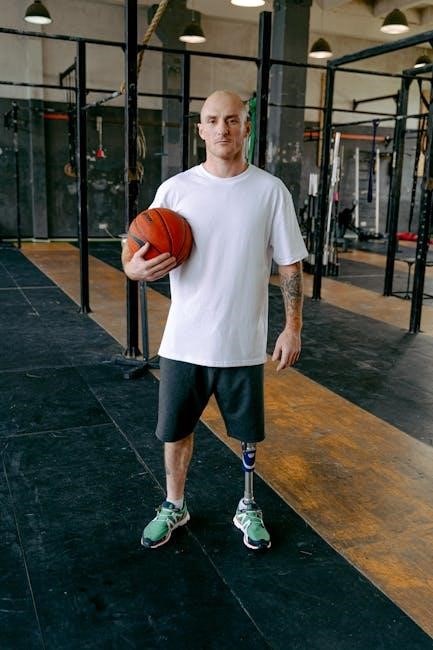Discover the essential exercises and strategies for recovering from LCL injuries. This guide provides a comprehensive approach to restoring strength, flexibility, and function in the knee. Learn how to safely progress through rehab and download a detailed PDF guide for structured recovery.
1.1 What is LCL and Its Importance
The lateral collateral ligament (LCL) is a critical structure on the outside of the knee, providing stability and preventing excessive movement. It plays a vital role in balance and proper joint function, especially during physical activities. Injuries to the LCL can significantly impair mobility and functionality, making rehabilitation essential for recovery. Understanding the LCL’s importance helps in appreciating the need for targeted exercises to restore strength and stability, ensuring optimal knee health and preventing future injuries. A strong LCL is key to maintaining active lifestyles and sports performance.
1.2 The Role of Rehabilitation in LCL Recovery
Rehabilitation is essential for restoring strength, stability, and function after an LCL injury. A well-structured program addresses pain, swelling, and limited mobility while promoting healing. Exercises and therapies help rebuild ligament strength and improve joint stability, reducing the risk of future injuries. Consistency and patience are key, as proper rehab ensures a safe return to daily activities or sports. Professional guidance can tailor exercises to individual needs, optimizing recovery and restoring full knee function.

Understanding LCL Injuries
LCL injuries involve damage to the lateral collateral ligament, crucial for knee stability. Understanding the injury’s nature, severity, and impact is vital for effective rehabilitation and recovery.
2.1 Common Causes of LCL Injuries
LCL injuries often result from direct blows to the knee, sudden twisting motions, or excessive stress on the ligament. Sports like football, basketball, and soccer are common scenarios due to collisions or awkward landings. Additionally, activities involving rapid changes in direction or improper training techniques can strain the LCL. Even everyday accidents, such as slipping or falling awkwardly, can lead to injury. Understanding these causes helps in developing preventive strategies and tailored rehabilitation plans.
2.2 Symptoms and Diagnosis of LCL Injuries
Common symptoms of LCL injuries include pain on the outside of the knee, swelling, instability, and a feeling of the knee giving way. Restricted movement and tenderness are also typical. Diagnosis begins with a physical exam, assessing tenderness and instability, often using the varus stress test. Imaging tests like X-rays or MRIs confirm the injury and rule out other issues.
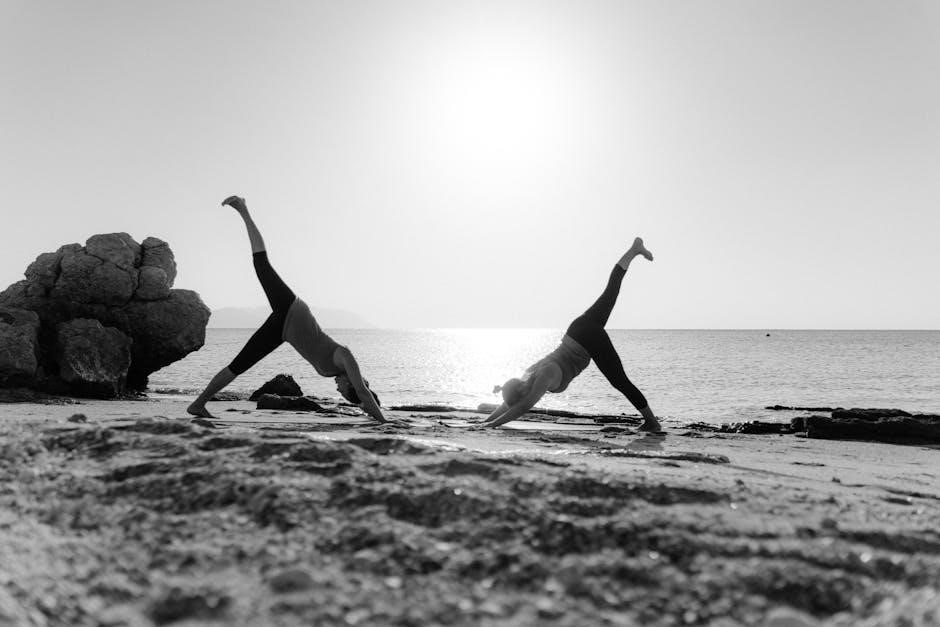
The Importance of Exercise in LCL Rehab
Exercise plays a vital role in LCL rehabilitation by restoring strength, improving flexibility, and enhancing joint stability. A well-structured program helps patients regain function and return to normal activities or sports, reducing the risk of future injuries and promoting overall knee health.
3.1 How Exercises Promote Healing and Strength
Exercises stimulate blood flow, delivering oxygen and nutrients to the injured LCL, fostering tissue repair. Strengthening the surrounding muscles, like the quadriceps and hamstrings, enhances knee stability. Progressive resistance builds strength gradually, promoting collagen synthesis for tendon remodeling. This structured approach ensures the LCL heals robustly, reducing reinjury risk and restoring functional movement. A well-designed program accelerates recovery, enabling a safe return to daily activities or sports.
3.2 Setting Realistic Goals for Rehabilitation
Setting realistic goals ensures a focused and effective recovery process. Start with short-term objectives, such as improving range of motion or reducing pain, before advancing to strength and functionality. Align goals with the severity of the injury and gradually increase intensity. This approach prevents overtraining and maintains motivation. Regularly assess progress to adjust targets, ensuring a balanced and sustainable path to full recovery. A structured plan keeps patients committed and ensures long-term success in LCL rehabilitation.
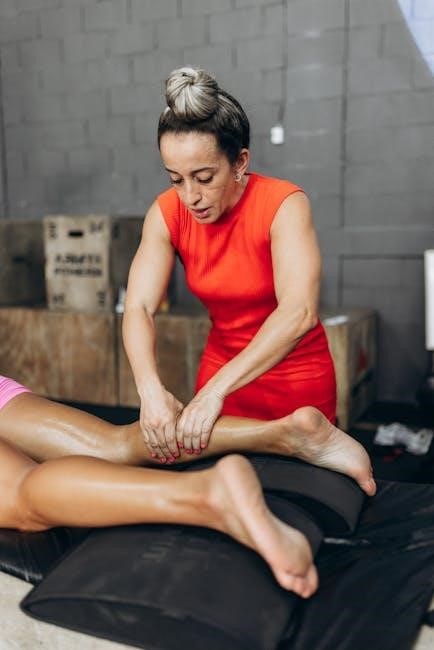
Early-Stage LCL Rehab Exercises
Initiate the healing process with gentle exercises to restore mobility and strength. Focus on low-impact movements like heel slides, straight leg raises, and seated stretches. These exercises promote healing without overloading the knee, laying the foundation for more intensive rehab.
4.1 Gentle Stretching Exercises
Gentle stretching is crucial in the early stages of LCL rehab to improve flexibility and range of motion. Focus on calf stretches, hamstring stretches, and IT band stretches to reduce stiffness. Perform these exercises slowly and hold each stretch for 20-30 seconds, repeating 2-3 times. Avoid bouncing or forcing the stretch beyond a comfortable range. These exercises help promote blood flow and prevent scar tissue formation, laying the groundwork for stronger, more mobile knees. Always prioritize pain-free movements and consult a healthcare provider if discomfort arises. Download the PDF guide for a detailed stretching routine tailored to LCL recovery.
4.2 Strengthening Exercises for the Knee
Strengthening exercises are vital for rebuilding knee stability and supporting LCL recovery. Focus on exercises like straight-leg raises, hamstring curls, and quadriceps sets to target key muscle groups. Use resistance bands or light weights to gradually increase intensity. Perform 2-3 sets of 10-15 repetitions, ensuring proper form to avoid strain. Strengthening the surrounding muscles helps stabilize the knee joint and prepares it for more dynamic movements. Download the PDF guide for a step-by-step strengthening routine designed to enhance knee function and promote a full recovery.
4.3 Mobility and Flexibility Work
Mobility and flexibility exercises are crucial for restoring knee movement and preventing stiffness during LCL recovery. Gentle exercises like heel slides, wall-assisted knee bends, and calf stretches help improve range of motion. Incorporate exercises that target the hamstrings, quadriceps, and calf muscles to enhance flexibility. Use foam rollers to release muscle tension and promote blood flow. Performing these exercises consistently ensures the knee joint remains mobile and prepares it for strengthening phases. Download the PDF guide for a detailed mobility and flexibility routine tailored to LCL rehabilitation.
Intermediate LCL Rehab Exercises
Build strength and stability with intermediate exercises designed to enhance knee function. Focus on progressive resistance, balance drills, and functional movements to prepare for advanced rehab phases. Download the PDF for detailed routines.
5.1 Progressive Resistance Training
Progressive resistance training strengthens the muscles around the knee, improving stability and function. Start with low-resistance exercises like leg presses or hamstring curls, gradually increasing intensity. Add resistance bands or light weights to enhance effectiveness. Focus on controlled movements to avoid strain. This method promotes muscle balance and joint stability, crucial for intermediate rehab. Incorporate functional movements to mimic daily activities or sports-specific actions, ensuring a smooth transition to advanced exercises. Download the PDF for detailed routines and progression tips.
5.2 Balance and Stability Exercises
Balance and stability exercises are crucial for restoring proprioception and joint stability post-LCL injury. Start with single-leg stands, gradually progressing to wobble board training or balance pads. Incorporate eyes-open and eyes-closed variations to challenge stability. These exercises enhance neuromuscular control and prevent future injuries. Consistency is key; modify difficulty based on progress. Download the PDF for detailed routines and tips to improve balance effectively during rehabilitation.
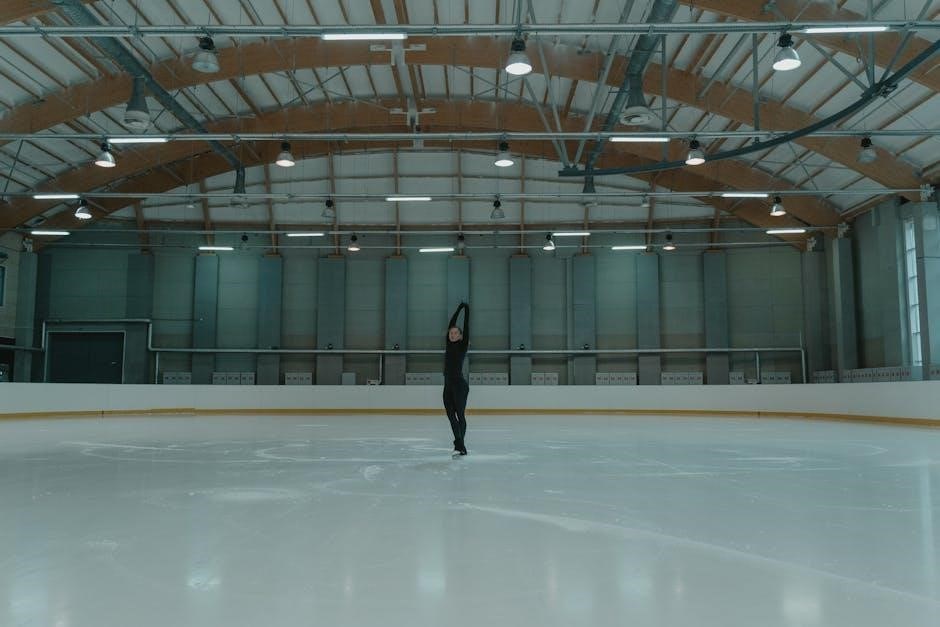
Advanced LCL Rehab Exercises
Advanced exercises focus on functional movements, agility drills, and dynamic stability. These high-level activities prepare the knee for sports and daily activities, ensuring full recovery. Download the PDF for detailed advanced routines.
6.1 Functional Movement Training
Functional movement training involves exercises that mimic real-life activities, such as squats, lunges, and step-ups. These movements help restore natural movement patterns, improve coordination, and rebuild confidence in the knee. By focusing on dynamic, multi-planar exercises, individuals can transition smoothly to daily activities or sports. This phase is crucial for achieving long-term stability and preventing future injuries. The downloadable PDF guide provides expert-designed routines to master these advanced techniques safely and effectively.
6.2 Agility and Sports-Specific Drills
Agility and sports-specific drills are designed to prepare the knee for dynamic movements and high-demand activities. Exercises like zig-zag running, cone drills, and shuttle runs improve reaction time, speed, and directional changes. These drills simulate real-game scenarios, helping athletes regain confidence and readiness for their sport. The downloadable PDF guide includes sport-specific routines to ensure a smooth transition back to competition. These advanced drills are tailored to rebuild agility and endurance safely.

Best Practices for LCL Rehab
Adhere to best practices for effective LCL recovery. Consistency, patience, and avoiding overtraining are key. Our downloadable PDF guide offers a structured plan for optimal results.
7.1 Consistency and Patience in Rehabilitation
Consistency and patience are cornerstone of successful LCL rehabilitation. Regular adherence to exercises ensures gradual healing and strength restoration. Avoid rushing the process, as overexertion can lead to setbacks. Celebrate small milestones to stay motivated. Psychological resilience plays a significant role in overcoming the challenges of recovery. Follow a structured plan and allow your body time to heal. With dedication and time, full recovery is achievable. Our downloadable guide provides a clear roadmap to support your journey. Stay committed and patient for optimal results.
7.2 Monitoring Progress and Avoiding Overtraining
Monitoring your progress during LCL rehabilitation is crucial to ensure safe and effective recovery. Track your exercises, pain levels, and functional improvements regularly. Avoid overtraining, as it can lead to setbacks or new injuries. Recognize signs of overtraining, such as increased pain or fatigue, and adjust your routine accordingly. Use the downloadable PDF guide to log your workouts and stay accountable. Balancing effort with rest ensures steady progress without compromising your recovery. A structured plan helps prevent overexertion while promoting long-term success.
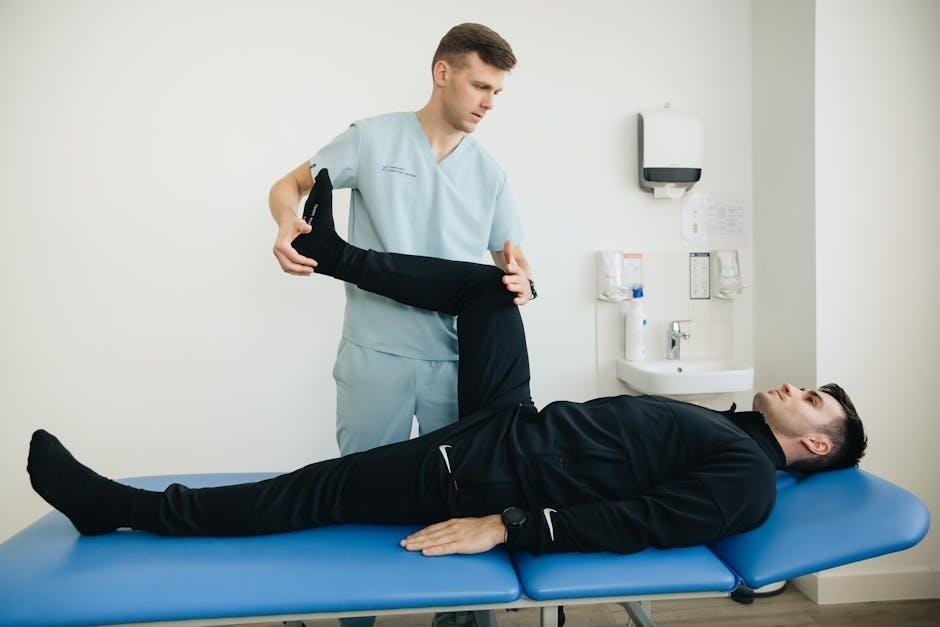
Downloadable LCL Rehab Exercises PDF
Access a comprehensive guide featuring detailed exercises, progress tracking, and recovery tips. This downloadable PDF ensures a structured and effective approach to rehabilitation, anytime and anywhere. Download now for clarity and convenience in your recovery journey.
8.1 How to Access the Comprehensive Guide
Accessing the LCL rehab exercises PDF is simple and straightforward. Visit our website, navigate to the resources section, and click the download link. The guide is free and instantly available, ensuring you can begin your recovery journey without delay. Designed for both patients and physical therapists, it provides a clear, structured plan tailored to your needs. Download now and gain immediate access to expert-backed exercises, progress tracking, and recovery tips to support your rehabilitation process.
8.2 Benefits of Using a Structured Exercise Plan
A structured exercise plan offers clarity and direction, ensuring a safe and effective recovery. It helps track progress, maintain consistency, and prevents overtraining. By following a well-designed plan, you can focus on specific exercises that target strength, flexibility, and stability. This approach minimizes the risk of further injury while promoting optimal healing. Additionally, a structured plan provides accountability and motivation, guiding you through each stage of rehabilitation with confidence. Download the PDF for a clear roadmap to full recovery.
Congratulations on completing this guide to LCL rehab exercises! By following the structured approach outlined here, you can effectively restore knee function, strength, and stability. Remember, consistency and patience are key to a successful recovery. The downloadable PDF provides a convenient resource to track your progress and stay motivated. Don’t hesitate to consult a healthcare professional for personalized advice. With dedication and the right exercises, you’ll be on your way to full recovery and returning to your normal activities. Download the PDF today and take the next step toward healing!
